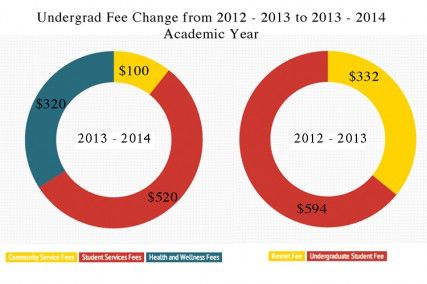
Boston University officials announced student fee costs for the 2013-2014 year Monday, which were broken down into community service fees, student services fees and student health fees, changed from last year’s undergraduate student fee and internet network fee.
The BU Budget Office carefully devised the new list of fees to ensure transparency regarding the allocation of students’ money, said BU spokesman Colin Riley.
“[The new system] is so that there is a good understanding of what these student fees go to support,” Riley said. “This [system] separates [the funds] and gives a clear sense of how much that funding is and where it’s available.”
For the 2013-14 academic year, undergraduate fees will total $940, marking a $14 increase from last year’s total fees, according to the Student Accounting Services website.
“The Resnet Fee is no longer, and the Undergraduate Student Fee is no longer — it’s now called ‘undergraduate student services,’” Riley said.
The Health and Wellness Fee will cost undergraduate students $160 per semester during the 2013-14 academic year, Riley said. There will also be a $260 per-semester Student Services Fee and a $50 per-semester Community Service Fee.
Riley said the Community Service Fee and the Student Services Fee were created to increase transparency and to ensure students would know where their money was being allocated.
“[The Budget Office] revamped the fees so that they are covering those areas that they specifically fund,” Riley said. “The Undergraduate Student Services fee supports student service operations and technology resources across the campus.”
During the 2012-13 academic year, the $297 per-semester Undergraduate Student Fee was allocated to fund clubs and club-sponsored activities, Riley said. Clubs will now be funded by the Community Service fee.
“The Community Service Fee is allocated directly to support student programs,” Riley said. “The Allocations Board, the Programming Council, the Resident Hall Association and Student Government distribute the majority of these funds to about 500 student groups and organizations.”
A number of students said they are pleased by the new visibility in allocation of funds.
Sabrina Salgia, a Sargent College of Health and Rehabilitation Sciences junior, said she is glad she now knows exactly where her money is going.
“I’m happy, because for the past three years me and my friends all complained about the [student fee],” Salgia said. “It’s good to know that now we have a direct allocation [of fees] now … It’s frustrating, because we don’t always know where the money goes.”
Hannah Walters, a College of Arts and Sciences senior, said she sees the reduced cost of funding to student clubs as a good thing because not all students participate in extracurricular activities and thus should not have to pay.
“This [new system] sounds like a pretty good policy, because some students might never take part in a club event all year, but they had to pay [the fee],” Walters said. “Or, there are certain types of clubs that might get more funding throughout the year, so this might be a little more fair for everyone.”
Victor Cervantes, a College of Engineering junior, said he is concerned clubs will suffer in the wake of these new changes due to funding inequality.
“The only thing I’m a bit concerned about is whether funding will still go out to those same divisions and in the same amounts,” Cervantes said. “I get the feeling that they’ll have enough, I just don’t know if it will be distributed equally.”
This is an account occasionally used by the Daily Free Press editors to post archived posts from previous iterations of the site or otherwise for special circumstance publications. See authorship info on the byline at the top of the page.



